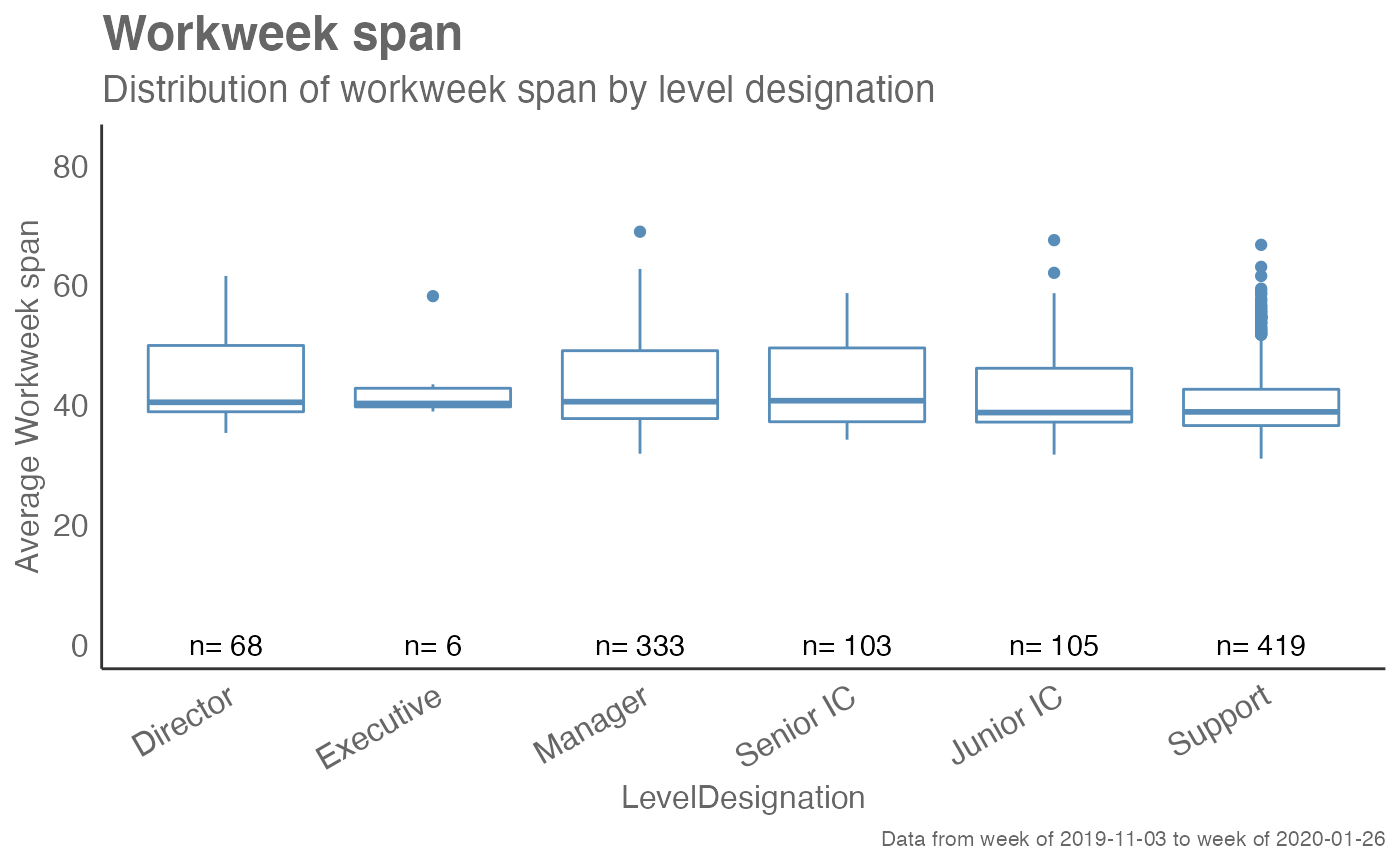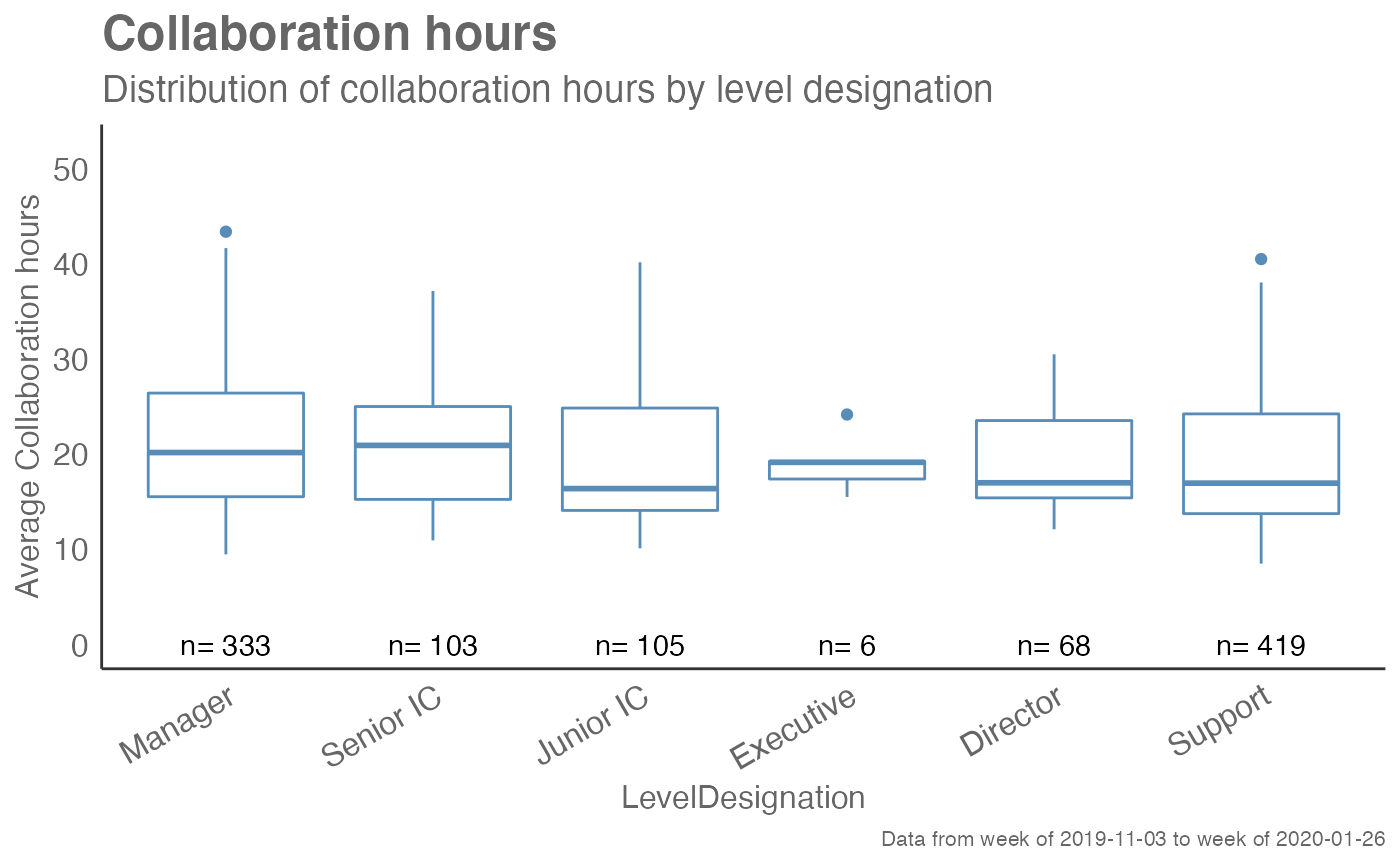Analyzes a selected metric and returns a box plot by default. Additional options available to return a table with distribution elements.
create_boxplot(
data,
metric,
hrvar = "Organization",
mingroup = 5,
return = "plot"
)Arguments
- data
A Standard Person Query dataset in the form of a data frame.
- metric
Character string containing the name of the metric, e.g. "Collaboration_hours"
- hrvar
String containing the name of the HR Variable by which to split metrics. Defaults to
"Organization". To run the analysis on the total instead of splitting by an HR attribute, supplyNULL(without quotes).- mingroup
Numeric value setting the privacy threshold / minimum group size. Defaults to 5.
- return
String specifying what to return. This must be one of the following strings:
"plot""table"
See
Valuefor more information.
Value
A different output is returned depending on the value passed to the return argument:
"plot": 'ggplot' object. A box plot for the metric."table": data frame. A summary table for the metric.
Details
This is a general purpose function that powers all the functions in the package that produce box plots.
See also
Other Visualization:
afterhours_dist(),
afterhours_fizz(),
afterhours_line(),
afterhours_rank(),
afterhours_summary(),
afterhours_trend(),
collaboration_area(),
collaboration_dist(),
collaboration_fizz(),
collaboration_line(),
collaboration_rank(),
collaboration_sum(),
collaboration_trend(),
create_bar(),
create_bar_asis(),
create_bubble(),
create_dist(),
create_fizz(),
create_inc(),
create_line(),
create_line_asis(),
create_period_scatter(),
create_rank(),
create_sankey(),
create_scatter(),
create_stacked(),
create_tracking(),
create_trend(),
email_dist(),
email_fizz(),
email_line(),
email_rank(),
email_summary(),
email_trend(),
external_dist(),
external_fizz(),
external_line(),
external_network_plot(),
external_rank(),
external_sum(),
hr_trend(),
hrvar_count(),
hrvar_trend(),
internal_network_plot(),
keymetrics_scan(),
meeting_dist(),
meeting_fizz(),
meeting_line(),
meeting_quality(),
meeting_rank(),
meeting_summary(),
meeting_trend(),
meetingtype_dist(),
meetingtype_dist_ca(),
meetingtype_dist_mt(),
meetingtype_summary(),
mgrcoatt_dist(),
mgrrel_matrix(),
one2one_dist(),
one2one_fizz(),
one2one_freq(),
one2one_line(),
one2one_rank(),
one2one_sum(),
one2one_trend(),
period_change(),
workloads_dist(),
workloads_fizz(),
workloads_line(),
workloads_rank(),
workloads_summary(),
workloads_trend(),
workpatterns_area(),
workpatterns_rank()
Other Flexible:
create_bar(),
create_bar_asis(),
create_bubble(),
create_density(),
create_dist(),
create_fizz(),
create_hist(),
create_inc(),
create_line(),
create_line_asis(),
create_period_scatter(),
create_rank(),
create_sankey(),
create_scatter(),
create_stacked(),
create_tracking(),
create_trend(),
period_change()
Examples
# Create a fizzy plot for Work Week Span by Level Designation
create_boxplot(sq_data,
metric = "Workweek_span",
hrvar = "LevelDesignation",
return = "plot")
 # Create a summary statistics table for Work Week Span by Organization
create_boxplot(sq_data,
metric = "Workweek_span",
hrvar = "Organization",
return = "table")
#> # A tibble: 5 × 8
#> group mean median sd min max range n
#> <chr> <dbl> <dbl> <dbl> <dbl> <dbl> <dbl> <int>
#> 1 Customer Service 41.6 40.2 5.19 34.0 58.4 24.4 61
#> 2 Finance 43.6 39.7 8.30 32.2 65.8 33.7 292
#> 3 Financial Planning 40.1 38.3 6.07 30.0 62.2 32.2 75
#> 4 Human Resources 44.0 42.5 6.27 32.6 59.6 27.0 71
#> 5 IT 41.8 40.6 6.54 31.6 62.6 31.0 130
# Create a fizzy plot for Collaboration Hours by Level Designation
create_boxplot(sq_data,
metric = "Collaboration_hours",
hrvar = "LevelDesignation",
return = "plot")
# Create a summary statistics table for Work Week Span by Organization
create_boxplot(sq_data,
metric = "Workweek_span",
hrvar = "Organization",
return = "table")
#> # A tibble: 5 × 8
#> group mean median sd min max range n
#> <chr> <dbl> <dbl> <dbl> <dbl> <dbl> <dbl> <int>
#> 1 Customer Service 41.6 40.2 5.19 34.0 58.4 24.4 61
#> 2 Finance 43.6 39.7 8.30 32.2 65.8 33.7 292
#> 3 Financial Planning 40.1 38.3 6.07 30.0 62.2 32.2 75
#> 4 Human Resources 44.0 42.5 6.27 32.6 59.6 27.0 71
#> 5 IT 41.8 40.6 6.54 31.6 62.6 31.0 130
# Create a fizzy plot for Collaboration Hours by Level Designation
create_boxplot(sq_data,
metric = "Collaboration_hours",
hrvar = "LevelDesignation",
return = "plot")
